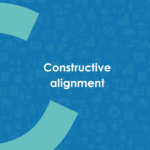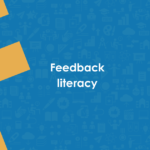
08 Jul Feedback
Students hand in the final version of their assignment. You start reviewing and get quite discouraged: why did students seemingly do nothing with the feedback you had put so much time into? Has it all been for nothing then? Maybe you don’t have to do everything yourself, but other activities like peer feedback can play a bigger role… Time to dive into the concept of feedback.
‘Feedback is one of the most influential processes on learning¹.’ This sentence is perhaps one of the most cited pieces of text in the educational science literature on testing or assessment. At the same time, the sentence in the original article was written in a more nuanced way: it clearly stated that this influence can be positive or negative. The effectiveness depends rather on the context and the type of feedback². So thinking carefully about how and when to provide students with feedback pays off.
A broader perspective
Before moving on, it is important to note that in recent years the concept of feedback has been explained from a different view³. The constructivist view states that students do not learn if you simply ‘send’ information to them. Rather, learning is an active process in which the learner has an important stake. The constructivist view has implications for how you look at feedback and deploy it. We often talk about feedback as teachers’ comments on students’ work. From the constructivist view, it is more than that. It is a process that involves both student and teacher. Better said:
Feedback is a process in which learners seek to understand information about their performance, and then use this information to improve the quality of their work or learning strategies⁴.
The definition makes it clear that if you have given qualitatively well-formulated feedback as a teacher, it does not necessarily mean that students have actually used it effectively. The feedback can be so well formulated, if students then do nothing with it, no feedback has taken place. There was only feedback information, but according to this definition, there was no feedback.
The definition also makes it clear that feedback does not necessarily have to come from a teacher in the form of (written) comments. Perhaps a student has asked another expert for it. Or maybe students could give peer feedback to each other. Artificial intelligence (AI) might even be able to fulfil this role.
So feedback is more than just teacher comments, but a process that you can set up in many ways to let students play an active role in that process. How do you design the feedback process so that students actually take that active role? We offer four tips.
1. Design: think about who, what and where
Precisely because feedback is a process, it is good to think about where and how you will implement this process in your teaching. An important question is also who is going to be the feedback giver. It does not always have to be the teacher. We often think that students learn mainly because they get a lot of information from the teacher. There are just many more times when students learn from feedback, and that happens especially when they themselves are involved in the process. For example, seeking and giving (peer) feedback are very valuable activities. Indeed, in certain contexts, giving feedback even seems to provide more learning gains than receiving it⁵. This is because while giving (peer) feedback, all kinds of things happen: students will have to make an assessment of the quality of the work and start thinking about next steps when formulating the peer feedback. What they learn from this process is then very useful for further improving their own work. So if you want to use feedback effectively, you can think further about how you want students to work with it.
Broadening your perspective on feedback also allows you to think smartly about the time investment you make as a teacher, and what you leave to students themselves. Stijn Vanhoof and Geert Speltincx wrote a book about using feedback in your teaching. They show that ensuring clear quality expectations among students, peer feedback and feedback on your own work are effective activities you can deploy even before you as a teacher give extensive feedback. The activities encourage students to engage in feedback and see their own part in the feedback process. It also makes them less dependent on your judgement as a teacher, which increases independence. In short: think carefully about how you use feedback in your teaching. It doesn’t always have to be more, it can also be smarter.
2. Support: help students give, receive and work with (peer) feedback
An active role of students in the feedback process, nice right? At the same time, all kinds of questions often arise, both from teachers and students. Can students give proper feedback? Do they know what quality is? Consequence of these doubts may be that teachers do not trust the quality of peer feedback. Perhaps teachers keep giving feedback themselves at the same time as peer feedback when it is not actually necessary. Students then push peer feedback aside and mainly look at teacher feedback. Blame them: after all, the teacher is ultimately the one who judges.
If you want students to take ownership of their own learning process, you will have to support and trust them. Working with feedback is a learning process in itself that requires practice, also called feedback literacy. There are several ways you can encourage and support that learning process. For example, have students formulate their own feedback questions before feedback is given. Explain to students how to give good feedback and let them practice. Talk to students about how to deal with emotions in the feedback process. And if you organise a peer assessment, increase self-confidence by showing examples of good feedback given by students themselves.
3. Timing: ensure feedback takes place before assessment
Once you know how feedback is given and who does it, it is important to think about timing. If you give teacher feedback, make sure that assessment does not take place at the same time. Feedback during assessment causes students to focus not on the feedback and learning, but on the assessment being given. Research shows that once an assessment is given (e.g. in the form of a grade), student learning for the subject stops⁶. Students simply do not look at the feedback. In addition, when teachers give grades, they often stop writing feedback that helps students move forward in their learning. The focus shifts to comments that focus on explaining the grades you give, but not what the student can do to improve. Precisely that improvement is what matters.
So for feedback to be effective, make sure the feedback process takes place before you move on to a final assessment. You also then give students the opportunity to do something with it before the final assessment, otherwise no feedback has taken place.
4. Action: complete the feedback process
A good feedback process becomes complete with the actual use of the feedback. After all, if it is not used, then all the time spent on it was for nothing. Activate students to engage with their feedback. The tips above already facilitate this process as much as possible by delaying giving a final assessment and working on feedback literacy. Nevertheless, it can’t hurt to also support students in using their feedback. This can be done, for example, by creating an action plan, where students actively start thinking about how they are going to use their feedback. Let them turn it into concrete action points, for example. Do they still have questions? If so, how will they get answers? Is there feedback that they disregard and why? By having students answer these questions, you help them take follow-up steps.
Feedback in Comproved
There are also several functions in Comproved that support the feedback process⁷,⁸. For example, there is the ‘ask for feedback’ function. Feedback is better accepted if it matches the questions a student already has anyway. To ensure that the student’s questions are also answered, the student can ask a question when submitting the work in the tool.
In Comproved, students give peer feedback to multiple fellow students by comparing each other’s work (anonymously). Through the process of comparison, students see many different works and thus examples of differences in quality. In addition, students receive feedback from multiple students and/or teachers. If you receive feedback from multiple peers, you will have to think critically about how to process it, as the feedback may contradict each other. With Comproved, you then also encourage students to get to work with the feedback by having them make a concrete feedback action plan that is built into the tool.
There’s so much more…
There is a lot to say about feedback, more than we can name here. If you want to dive further into the concept, there is more than enough material to choose from. For instance, a number of researchers have made a list of key elements that contribute to an effective feedback process⁹. This list is about setting up the feedback process in education itself, but also about creating the right culture in the workplace to use feedback in the right way. If you want to know more about this, read on here for a detailed explanation and examples for each point mentioned. Which elements do you already see in your own practice?
Literature
¹Hattie, J., & Timperley, H. (2007). The power of feedback. Review of educational research, 77(1), 81-112. https://doi.org/10.3102/003465430298487.
²Wisniewski, B., Zierer, K., & Hattie, J. (2019). The power of feedback revisited: A meta-analysis of educational feedback research. Frontiers in Psychology, 10, https://doi.org/10.3389/fpsyg.2019.03087.
³Little, T., Dawson, P., Boud, D., & Tai, J. (2024). Can students’ feedback literacy be improved? A scoping review of interventions. Assessment & Evaluation in Higher Education, 49(1), 39-52. https://doi.org/10.1080/02602938.2023.2177613.
⁴Boud, D., & Molloy, E. (2013). Rethinking models of feedback for learning: the challenge of design. Assessment & Evaluation in Higher Education, 38(6), 698-712. https://doi.org/10.1080/02602938.2012.6914624.
⁵Lundstrom, K., & Baker, W. (2009). To give is better than to receive: the benefits of peer review to the reviewer’s own writing. Journal of Second Language Writing, 18, 30-43. https://doi.org/10.1016/j.jslw.2008.06.002.
⁶Winstone, N.E., & Boud, D. (2020). The need to disentangle assessment and feedback in higher education. Studies in Higher Education 47(3), 656-667. https://doi.org/10.1080/03075079.2020.1779687.
⁷van Gasse, R., Bouwer, R., Goossens, M., & De Maeyer, S. (2017). Competenties kwaliteitsvol beoordelen met D-PAC. Examens: Tijdschrift voor de Toetspraktijk, 1(1), 11-17.
⁸Bouwer, R., Goossens, M., Mortier, A. V., Lesterhuis, M., & De Maeyer, S. (2018). Een comparatieve aanpak voor peer assessment: Leren door te vergelijken. In D. Sluijsmans & M. Segers (Eds.), Toetsrevolutie: Naar een feedbackcultuur in het hoger onderwijs (p. 92-106). Culemborg, NL: Phronese.
⁹Henderson, M., Phillips, M., Ryan, M., Boud, D., Dawson, P., Molloy, E., & Mahoney, P. (2019). Conditions that enable effective feedback. Higher Education Research & Development, 38(7), 1401-1416. https://doi.org/10.1080/07294360.2019.1657807.




